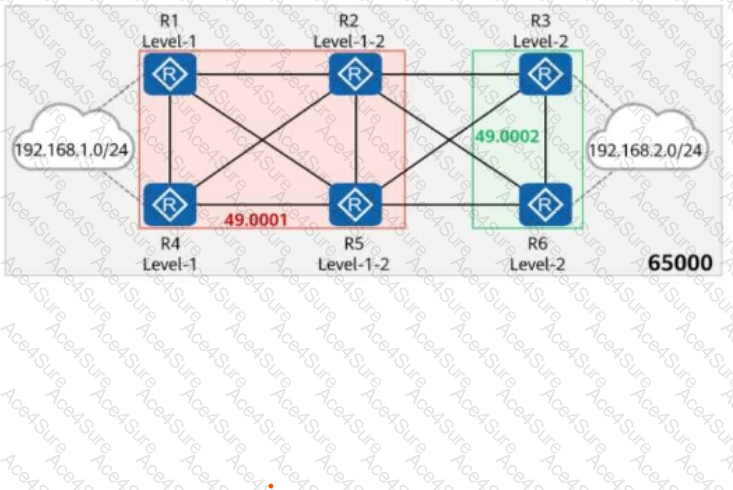Comprehensive and Detailed In-Depth Explanation:
Understanding the BGP and IS-IS Network Topology in the Question:
IS-IS Areas:
Area 49.0001 (Level-1 IS-IS): Contains R1, R2, R4, R5.
Area 49.0002 (Level-2 IS-IS): Contains R3, R6.
R2 acts as an ABR (Area Border Router) and redistributes routes between Level-1 and Level-2 using import-route isis level-2 into level-1.
BGP Route Reflection & Peering:
R2 and R5 are Route Reflectors (RRs).
iBGP peering is established among all routers (R1, R2, R3, R4, R5, R6).
R1 and R4 import 192.168.1.0/24 into BGP, meaning this prefix will be advertised to all iBGP peers.
R3 and R6 import 192.168.2.0/24 into BGP, meaning this prefix will also be advertised to all iBGP peers.
Route Distribution Analysis:
A. The route 192.168.2.0/24 in the routing table of R4 has two next hops. ✅ (Correct)
R3 and R6 import 192.168.2.0/24 into BGP.
R2 and R5 (Route Reflectors) learn this route and reflect it to their clients (R1, R3, R4, R6).
R4 receives two valid paths to 192.168.2.0/24 via R2 and R5 (both iBGP peers).
Since both routes have the same BGP attributes and cost, they are installed as equal-cost paths in R4's routing table.
✅ Statement A is correct: The routing table of R4 has two next hops for 192.168.2.0/24.
B. The routing table of R1 contains two equal-cost default routes. ❌ (Incorrect)
In an IS-IS Level-1-2 setup, default routes are usually provided to Level-1 routers from an ABR (like R2).
However, the question does not mention that R1 is receiving two default routes or that it is in an equal-cost multipath (ECMP) scenario.
R1 may have only one default route, depending on route preference and cost.
❌ Statement B is incorrect: The routing table of R1 does not necessarily contain two equal-cost default routes.
C. The routing table of R4 contains two equal-cost default routes. ❌ (Incorrect)
Similar to R1, R4 is also a Level-1 router in IS-IS.
If R4 were receiving default routes from multiple ABRs (R2 and R5), then it could have equal-cost paths.
However, there is no indication that R4 is receiving two default routes in this scenario.
❌ Statement C is incorrect: The routing table of R4 does not necessarily contain two equal-cost default routes.
D. The routing table of R1 contains the route 192.168.2.0/24. ✅ (Correct)
R3 and R6 import 192.168.2.0/24 into BGP.
R2 and R5 (Route Reflectors) reflect this route to their iBGP peers, including R1.
Since R1 is an iBGP client of R2 and R5, it will receive 192.168.2.0/24 and install it in its routing table.
✅ Statement D is correct: The routing table of R1 contains the route 192.168.2.0/24.
Final Conclusion:
✅ A. The route 192.168.2.0/24 in the routing table of R4 has two next hops.❌ B. The routing table of R1 does not necessarily contain two equal-cost default routes.❌ C. The routing table of R4 does not necessarily contain two equal-cost default routes.✅ D. The routing table of R1 contains the route 192.168.2.0/24.
Thus, the correct answers are: A, D.
[Reference:, HCIP-Datacom-Advanced Routing & Switching Technology V1.0 – BGP Route Reflection and iBGP Route Distribution, Huawei Official HCIP-Datacom Study Guide – IS-IS Route Redistribution into BGP, Huawei Documentation on BGP Route Reflectors and Import-Route Behavior, , , , ]



